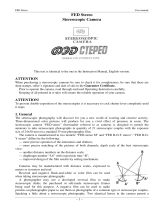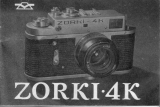Page is loading ...

FED-2 Instruction manual
– 1 –
FED 2
Fed-2 35mm FILM CAMERA instruction manual
This text is NOT identical to the one in the official Instruction Manual.
Fed-2 frontal View
01. Film Counter
02. Film wind knob
03. Rangefinder optic
04. Aperture index dot
05. Scale setting ring
06. Viewfinder aperture
07. Automatic releaser button
08. Automatic releaser lever
09. Synchronizer socket
10. Front lens nut
11. Aperture setting ring
12. Depth of field scale
13. Focusing ring
This manual contains a brief description of camera Fed-2 and the basic rules
for using the camera. It
cannot serve as a photography manual.
Slight differences between the description and the camera may occur as a
result of technical
modification being introduced in the design of the camera.
Camera Fed-2 operated on standard 35 mm film with a picture size of
24×36 mm. The great
resolving power of the lens makes it possible to
obtain perfect large-size pictures. The wide range of
shutter speeds,
the trigger winder, synchronizer, automatic releaser, dioptric view-finder setting, the
light weight and compactness of the camera will
satisfy the requirements of either amateur or
professional
photographer. The camera is fitted with lens Industar-26M or with
Industar-61 with
lanthanum Optics. The camera is so designed that it
is also possible to use interchangeable lenses
Industar-50, Jupiter-9, Jupiter-11, Jupiter-12 and others. In taking a picture the camera
is focused with
the help of the range-finder. The automatic releaser
incorporated in the camera allows

FED-2 Instruction manual
– 2 –
the photographer to take pictures
of himself. The automatic shutter speed ranging from 1/500 to
1/25
(1/30) sec permits the photographer to use the camera under any
lighting conditions. At the bottom of
the camera there is a socket
for a tripod. It is possible to photograph with a tripod without
taking the
camera out of its case.
Fed-2 rear View
14. Dioptric correction level
15. Rewind knob
16. Shutter speed selection knob
17. Shutter speed scale
18. Rewind release ring
19. Shutter release button
20. Frame counter disc
21. GOST film speed reminder
22. Range and viewfinder eyepiece
23. Accsessory shoe
24. Base locking latch.

FED-2 Instruction manual
– 3 –
The camera can be loaded under ordinary soft lighting conditions in the
following way. By turning
the nut on the case bottom unscrew the tripod screw
retaining the camera, remove the camera from the
case. Raise the lock shackles
with the nail and turn them half-way round as far as they will go. Then
pressing with the thumbs, shift the camera back in such a way that its edge
comes out of the camera
slot and remove it.
Open the camera and take out the take-up reel and magazine. The reel is removed
with a certain
amount of effort. Load the magazine with film (the magazine is
loaded in the darkness). Having pulled
out a free end of film about 10cm long
from the magazine, fasten it on the reel in such a way that the
spring tooth
enters one of the perforations.
Fit the take-up reel on the bush and then place the magazine in the camera. At
this point the film
should be slightly stretched and the teeth of the sprocket
should enter the perforations of the film.
Close the camera.
The unexposed film is fed to the picture aperture by winding the shutter twice
pressing the release
button after each winding. The winding lever should be
turned as far as it will go.
When properly loaded the camera is wound easily without jerky motions and
noticeable efforts.
Then by turning the dial scale set the “O” point of the
picture counter opposite the indicator. Align the
sensitivity scale dial with
the film-type indicator index in accordance with the data of the film loaded in
the camera. The film indicator is a memory device consisting of a movable
sensitivity scale in film
speed units (ASA, DIN) and a stationary indicator
with conventional designations of film types.
The camera is equipped with lens “Industar-26M” or “Industar-61” with lanthanum
optics. The
scales are located on the lens mount. The diaphragm scale 1
indicates changes in the lens speed. When
focusing, the depth-of-field scale 2
indicates on the distance scale the limits within which the range
sharpness
will be satisfactory for each selected diaphragm value. The distance scale 3 serves for
focusing the lens. The scale designations correspond to the distance
from the object being
photographed to the surface of the film in meters.
The camera is focused with the help of optical range-finder. In order to set
the camera at an accurate
and proper focus turn the lever of the dioptric
focusing, focus the view-finder by sight (the dioptric
focusing mechanism
provides a correction of ± diopters).

FED-2 Instruction manual
– 4 –
Then aim the camera at the object to be photographed. In the center of the
field of view of the view-
and range-finder a disc differing in color is seen,
in which the image will be doubled.
By turning the distance ring of the lens align the image
into one. It
is recommended to set the camera
approximately in the middle third of
the light field.
In order to set the necessary exposure, slightly raise
the head, turn it
till index coincides with the division
of the exposure scale and lower
the head back in place.
The exposure can be set only with the shutter
wound up.
Do not turn the head in the interval between 30 and 1.
The number on the scale show the exposure values provided
automatically by the shutter (1/25(1/30)-1/500sec) “B”
serves for
obtaining prolonged exposures “by hand”.
In order to wind the automatic releaser the lever is
turned counter clock-wise from the bottom
position and
into the top position. Then press the release button of
the automatic releaser and stand in the spot selected beforehand. The shutter
will go of from 9 to 15
sec after the automatic releaser is switched on.
It is possible to wind the shutter with the automatic releaser either released
or wound up. A flash
lamp can be used only at a 1/30 (1/25) sec exposure. When
photographing with a lamp place the lamp
reflector in the camera shoe and
insert the lamp plug pin wire in the synchronizer socket. The
diaphragm should be selected in accordance with the sensitivity of the film, the distance to the
photographed objected and the lamp power.
More detailed information on photographing with flash lamps can be obtained by
referring to a
manual on lamps and photography.
The following order of
working
with the camera is
recommended.
Open the case; remove the
protective cover from the
lens.
Looking into eyepiece
of the view-
and range finder
select the spot to be
photographed and he desired
arrangement of image in the
picture.
Focus the lens.
Set the diaphragm in
accordance
with the required
field depth. Turning
the
lever, wind up the camera
shutter.
Set the shutter
exposure head at the
required
exposure. Aim the camera at
the object to be photographed and
smoothly and evenly press the release
button. If the light source is in
front of
the camera, use a sunshade.
IMPORTANT!!! NEVER CHANGE SHUTTER SPEEDS WITHOUT FIRST COCKING
THE SHUTTER!!!
In the worst case, you may do major damage to the mechanism. At best, you will
find the shutter
behaves erratically for a few frames.
Before opening the camera the exposed film should be rewound into the magazine.
For rewinding
the film disengage the shutter mechanism by pressing the fluted
edge of the disengaging bush
downwards with the thumb of he right hand and
turning the bush towards letter “B” (return)
whereupon the disengaging bush
should sink. In rewinding the film the lens should be covered.
The rewinding head is turned in the direction indicated by the arrow. Complete
rewind of the film is
defined by the effort needed for pulling out the film
from the take-up reel. Open the camera and take
out the film.
The camera is designed for long service life when used properly.

FED-2 Instruction manual
– 5 –
POSSIBLE PROBLEMS
FED 2 RANGEFINDER ADJUSTMENT
It is highly unlikely that the rangefinder may
be out of adjustment. You will only know if this
is a
problem after you have put a film through the camera. You will be able to ascertain if it needs
adjustment from a
selection of photographs
taken at various distances
from infinity right down to
a metre or so. It is
also
possible for the distance
scale on the lens to be
slightly out. From my
experiences it is going to
be unusual for a FED 2 to
be out of adjustment and
even if it is I would
recommend that you adjust
it only if it causing you
problems.
1. Rangefinder horizontal alignment
You can adjust the rangefinder horizontal alignment by removing the screw
adjacent to the E on the
FED logo seen on the front of camera. Under this screw
you will find access to a smaller diameter
screw. Set the lens to infinity and
looking through the rangefinder turn the screw very gently using no
force
whatsoever so that the two images line up.
2. Rangefinder vertical alignment
You can adjust the rangefinder vertical alignment by removing the circular knurled metal surround
on the rangefinder window adjacent to the letter F or flash socket. Rotate the brass inner ring not the
outer ring. There are two slots opposite each other that you can insert a pin into and turn. Do not use
any force.
I must point out that the rangefinder is only a guide and I cannot emphasize this enough, it is
probably not worth adjusting it even if it is out of adjustment. They are all slightly off; even
contemporary Leicas and Contax rangefinders are slightly out of adjustment at infinity or close up. The
best you can realistically hope for is that it is accurate from 5 metres to infinity or from 1 to 20 metres.
If you are willing to accept these limitations, then the good thing about a long 67 mm base rangefinder
is that it can be particularly accurate at focusing.
The other problem that you can have with rangefinders is that they can be seized up and need to be
freed with some lubricant. If you remove the lens you will see the rangefinder lever and shaft running
through from the lens chamber to the rangefinder chamber lever backwards and forwards. Apply a
small drop of oil to this shaft very carefully working the lever. Do not use any force and be careful not
to get oil everywhere.

FED-2 Instruction manual
– 6 –
You’ll need to do the
following: (look at the picture)
open the bottom, you’ll see 4 bolts.
You can regulate the first
curtain (it opens the shutter) with
the bolts 1 and 2. The bolts 3 and 4
are for the second curtain (it closes
the shutter). The bolt 1 and 3 are
for fixing, the bolt 2 and 4 are for
regulation of the curtains. Take off
the lens, put the shutter speed in
position “B”, cock a lever and
press a shutter button. Look at
which of the curtains moves
slowly.
For example, the second curtain
(it closes the shutter) moves
slowly. In that case you need to
unscrew the bolt 3, and turn
around one or twice the bolt 4
(anticlockwise).
For example two, the second curtain (it closes the shutter) moves quickly. In that case you need to
unscrew the bolt 3, and turn the bolt 4 (clockwise) once or twice. This method is used for all Leica type
cameras, Zorki and FED.
http://eugigufo.net/download/photovideo/
/











